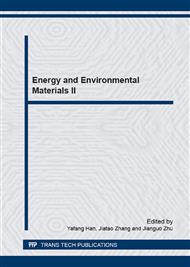[1]
M.T. Elm, T. Henning, P.J. Klar, B. Szyszka, Effects of artificially structured micrometer holes on the transport behavior of Al doped ZnO layers, Appl. Phys. Lett. 93 (2008) 232101.
DOI: 10.1063/1.3040312
Google Scholar
[2]
K. Jung, W.K. Choi, S.J. Yoon, H.J. Kim, J.W. Choi, Electrical and optical properties of Ga doped zinc oxide thin films deposited at room temperature by continuous composition spread, Appl. Surf. Sci. 256 (2010) 6219–6223.
DOI: 10.1016/j.apsusc.2010.03.144
Google Scholar
[3]
L. Gong, Z.Z. Ye, J.G. Lu, L.P. Zhu, J.Y. Huang, X.Q. Gu, B.H. Zhao, Highly transparent conductive and near-infrared reflective ZnO: Al thin films, Vacuum. 84 (2010) 947–952.
DOI: 10.1016/j.vacuum.2010.01.010
Google Scholar
[4]
C. Guillen, J. Herrero, Optical electrical and structural characteristics of Al: ZnO thin films with various thicknesses deposited by DC sputtering at room temperature and annealed in air or vacuum. 84 (2010) 924–929.
DOI: 10.1016/j.vacuum.2009.12.015
Google Scholar
[5]
S. Benramache, B. Benhaoua and H. Bentrah, Preparation of transparent, conductiveZnO: Co and ZnO: In thin films by ultrasonic spray method, J. Nanostruct. Chem. 3(2013) 54, 3.
DOI: 10.1186/2193-8865-3-54
Google Scholar
[6]
J. Ramesh, G. Pasupathi, R. Mariappan, V. Senthil Kumar and V. Ponnuswamy, Struc-tural and optical properties of Ni doped ZnO thin films using sol–gel dip-coatingtechnique, Optik. 124 (2013) 2023–(2027).
DOI: 10.1016/j.ijleo.2012.06.035
Google Scholar
[7]
H. Zhang, S. Yang and H. Liu, et al, Preparation and characterization of transparentconducting ZnO: W films by DC magnetron sputtering, J. Semicond. 32(2011) 043002.
DOI: 10.1088/1674-4926/32/4/043002
Google Scholar
[8]
A.E. Manouni, F.J. Manjon and M. Perales, et al, Effect of thermal annealing onZnO: Al thin films grown by spray pyrolysis, Superlattices Microstruct. 42(2007) 134–139.
DOI: 10.1016/j.spmi.2007.04.005
Google Scholar
[9]
T. Yamamoto and H. Yoshida, Physics and control of valence states in ZnO by codoping method, Physica B. 302 (2001) 155–162.
DOI: 10.1016/s0921-4526(01)00421-5
Google Scholar
[10]
H.Y. Lee, Y.H. Chou, C.T. Lee, W.Y. Yeh and M.T. Chu, Mechanisms of lighting enhancement of Al nanoclusters-embedded Al doped ZnO film in GaN-based light-emitting diodes, J. Appl. Phys. 107 (2010) 014503.
DOI: 10.1063/1.3276092
Google Scholar
[11]
Y.S. Kim and W.P. Tai, Electrical and optical properties of Al-doped ZnO thin films by sol–gel process, Appl. Surf. Sci. 253 (2007)4911–4916.
DOI: 10.1016/j.apsusc.2006.10.068
Google Scholar
[12]
Y.H. Kim, K.S. Lee, T.S. Lee, B. Cheong, T.Y. Seong and W.M. Kim, Effects of substrate temperature and Zn addition on the properties of Al-doped ZnO films prepared by magnetron sputtering, Appl. Surf. Sci. 255 (2009) 7251–7256.
DOI: 10.1016/j.apsusc.2009.03.075
Google Scholar
[13]
H.Y. Yue, A.M. Wu, Y.D. Feng, X.Y. Zhang and T.J. Li, Structures and properties of the Al-doped ZnO thin films prepared by radio frequency magnetron sputtering, Thin Solid Films. 519(2011) 5577-5581.
DOI: 10.1016/j.tsf.2011.03.026
Google Scholar
[14]
J. Lee, D. Lee, D. Lim and K. Yang, Electrical and optical properties of ZnO: Al films deposited on flexible organic substrates for solar cell applications, Thin Solid Films. (2007) 6094–6098.
DOI: 10.1016/j.tsf.2006.12.099
Google Scholar
[15]
B.L. Zhu, J. Wang, S.J. Zhu, J. Wu, D.W. Zeng and C.S. Xie, Optimization of sputtering parameters for deposition of Al-doped ZnO films by r. f magnetron sputtering in Ar+H2 ambient at room temperature, Thin Solid Films. 520(2012) 6963–6969.
DOI: 10.1016/j.tsf.2012.07.049
Google Scholar
[16]
M. Saad and A. Kassis, Effect of r. f power on the properties of rf magnetron Sputtered ZnO: Al thin films, Mater. Chem. Phys. 136(2012) 205–209.
DOI: 10.1016/j.matchemphys.2012.06.053
Google Scholar
[17]
D.K. Kim, H.B. Kim, Dependence of the properties of sputter deposited Al-doped ZnO thin films on base pressure, J. Alloys Compd. 522(2012) 69–73.
DOI: 10.1016/j.jallcom.2012.01.078
Google Scholar
[18]
D. Song, Effects of r. f power on surface-morphological, structural and electrical properties of aluminium-doped zinc oxide films by magnetron sputtering, Appl. Surf. Sci. 254(2008) 4171–4178.
DOI: 10.1016/j.apsusc.2007.12.061
Google Scholar
[19]
J.P. Kar, S. Kim, B. Shin, K.I. Park, K.J. Ahn, W. Lee, J.H. Cho and J.M. Myoung, Influence of sputtering pressure on morphological, mechanical and electrical properties of Al-doped ZnO films, Solid-State Electron. 54(2010) 1447–1450.
DOI: 10.1016/j.sse.2010.07.002
Google Scholar
[20]
Z.Y. Zhang, C.G. Bao, W.J. Yao, S.Q. Ma, L.L. Zhang and S.Z. Hou, Influence of deposition temperature on the crystallinity of Al-doped ZnO thin films at glass substrates prepared by RF magnetron sputtering method, Article Superlattices and Microstructures. 49(2011).
DOI: 10.1016/j.spmi.2011.04.002
Google Scholar
[21]
W. Gao and Z.W. Li, ZnO thin films produced by magnetron sputtering, Ceramics International. 30(2004) 1155-1159.
DOI: 10.1016/j.ceramint.2003.12.197
Google Scholar
[22]
J.K. Song and H.J. Yang, Influence of substrate temperature on the optical and piezoelectric properties of ZnO thin films deposited by r. f magnetron sputtering, Applied Surface Science. 253 (2007) 7330-7335.
DOI: 10.1016/j.apsusc.2007.03.020
Google Scholar
[23]
L. Cui, H.Y. Zhang, G.G. Wang, F. X. Yang, X.P. Kuang, R. Sun and J.C. Han, Effect of annealing temperature and annealing atmosphere on the structure and optical properties of ZnO thin films on sapphire (0 0 0 1) substrates by magnetron Sputtering, Applied Surface Science. 258 (2012).
DOI: 10.1016/j.apsusc.2011.10.076
Google Scholar
[24]
J.S. Liu, Z.Q. Li, K.J. Zhu, M.X. He, M.Q. Cong, S. Zhang, J. Peng and Y.N. Liu, The effects of ZnO layer and annealing temperature on the structure, optical and film–substrate cohesion properties of SiGe thin films prepared by radio frequency magnetron sputtering, Applied Surface Science. 259(2012).
DOI: 10.1016/j.apsusc.2012.07.057
Google Scholar
[25]
H.F. Liu and Q.S. Guo, Comparison of Preparation and performance between Ti-doped ZnO Thin Films and Ti-Al Co-doped ZnO Thin Films, Journal of Synthetic Crystals. 39(2010) 1152-1155.
DOI: 10.1166/mex.2015.1218
Google Scholar


